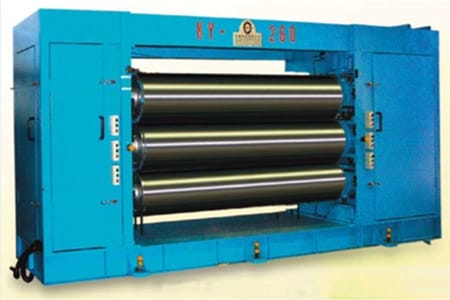Calendering is a finishing process for the surface modification or densification of materials. Calendering occurs by passing these materials through s series of rollers. The machine containing the rollers is called a calender, a term derived from kylindros the Greek word for cylinder. Modern calenders have rollers made from cast iron or steel with hardened or soft surfaces, depending upon their use. For some applications, rollers are heated or cooled. Figure 1 (below) is a picture of a three-roller calender.

Fig 1: Three-roller Calender
Many industries use calenders including nonwovens, paper, textiles, plastic films, rubber, and batteries. High-pressure, precision, and geotextile thermal-bonding and laminating calenders are used for nonwovens. Applications for nonwovens include automotive materials, construction, filtration, agricultural, medical, and personal care/hygiene, to name a few.
Paper products can be treated and enhanced in many ways to change their appearance and functionality. Glossy finishes and embossing are created using calenders. For textiles, calendering is used on fabrics such as moiré, to produce its watered effect, and also on cambric and some types of sateens.
Plastic films are formed, embossed, laminated and finished on calendering equipment. In the rubber industry, fabric, rubber, or plastics are passed through a series of calender rollers to flatten, smooth and commingle the various materials, resulting in the various materials being sandwiched together (e.g. the plies in a tire).
The battery industry also relies on calenders. For example, the electrodes for lithium-ion and lithium manganese dioxide batteries are densified using high-pressure calenders.
The common factor for all calendering operations is that high pressure is exerted on the materials being calendered. Nip Pressure is the term for the load on the web (material) passing between two rolls which run together to press the sheet. Unfortunately for manufacturers, nip pressure is difficult to directly measure without special tools.
Sensor Products Inc. is a world leader in the niche field of tactile surface pressure and force sensors. Our sensors are thin-film elements that reveal actual contact (interfacial) pressure and distribution between any two mating or impacting surfaces. Our products are analytical tools used in the manufacturing and R&D processes by engineers and technicians. Our customized and off-the-shelf systems are installed within all of the Fortune 500 industrial companies.
The following products are useful in measuring pressure in calenders.
- EZ-Nip® is a thin color changing pressure activated paper used to detect uneven nip rollers in paper making and converting machinery. EZ-Nip® determines the actual working, static nip width between two mating rolls.
- DigiNip® is a powerful system that allows the quick and easy diagnosis of roller conditions at the nip contact point.
- With Sigma-Nip® you are able to calculate and record nip width at multiple points across your rollers face length in real-time with unprecedented speed, accuracy and repeatability. The new Sigma-Nip® system is not only more accurate, but can record higher pressures than ever previously attainable.
- Fujifilm Prescale® film is useful in a large variety of applications including measuring nip pressure and roll contact pressure. The film aids in determination of uniform loading in a press’s cross direction, as well as improving felt and cover life and consistent web compaction. Both dynamic and static impressions can be taken. Fujifilm Prescale® will ensure parallelism between nipped rolls during roll changing as well as during routine downtime.
- The Auto-NIS imager is a Windows-based system that enables the interpretation and analysis of Fujifilm Prescale® and Fujifilm Prescale nip impression films. Using Auto-NIS® to analyze your nip impression films aids in ascertaining proper roller crowning and parallelism. Auto-NIS® can scan impression film of any length capturing all of the data across the film’s width.


